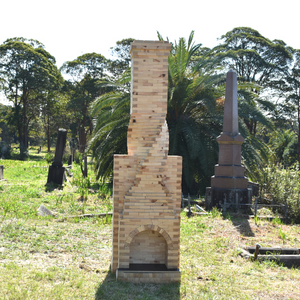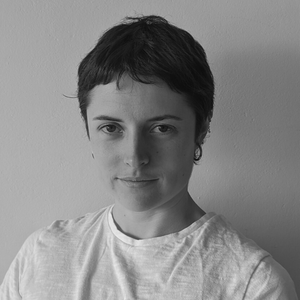Hearth (2020)
Pine, formply, glue and nails

Hearth is based on a brick fireplace that stands as the last surviving part of an 1800s cottage in Kiah, which was destroyed in the f ires of January 2020. A fireplace without a house is a jarring sight – as a stripped back and estranged object, it stands as a memorial. Half the size of the original, and built of combustible material, this replica has reduced both the scale and the endurance of the original fireplace. Highly flammable, Hearth anticipates its own end, and at the same time speaks of the ultimate impermanence of the original fireplace at Kiah.
About the Artist

Whimbrel Wilson lives on Cammeraygal Country in Northern Sydney. She uses and responds to found existing objects in her work. Whimbrel is interested in collection and arrangement, and the narratives, transformations, and histories that objects hold. She thinks of objects’ histories as her collaborators, and of her intervention as a single point in an object’s evolution. Whimbrel graduated with a BFA from the National Art School in 2020.
Transcription
Hello, my name's Whimbrel and the work I'm exhibiting in HIDDEN is called Hearth. Hearth is a replica of the brick fireplace and chimney that was the last standing piece of my grandparents 1800's cottage.
The cottage was in Kaya in southern New South Wales and it burnt down in the twenty-twenty bushfires. Where fires are swept through, fireplaces are left as these sort of estranged pillars that jut out of the landscape and they end up standing as memorials to the homes that they were once a heart of. This fireplace was double sided. One side faced the living room and the other side formed the stove in the kitchen. The chimney took on a striking twisting form which my grandpa said drew the smoke upwards and out.
When the house burnt down, the form of the fireplace and chimney was revealed in its entirety. It was sitting in a landscape that had been completely transformed by the fire. Scattered contents from inside the house were melted and morphed into fascinating new objects. The Earth was completely black and you could see across vast areas which before had been screened by thick vegetation. This transformation has continued since I made Hearth back in twenty-twenty with life coming back to the landscape in really unexpected ways.
Transformation is definitely something that informed my process in the making of this work. Hearth is a replica which transforms the original fireplace to carry a sense of impermanence and vulnerability. It's been transformed in its scale, its materiality and its longevity. It's about half the size of the original fireplace, made from individually hand sewn timber blocks. There was something childlike in building it with blocks, and had been told it looks like a Jenga tower. I think this sense of fragility stands in contrast to its monumental form as a combustible fireplace. It also has an innate vulnerability. At the conclusion of HIDDEN the idea is to transport the replica to Kaya, where their original still stands, and to light a fire in it.
The shortened lifespan of the replica is a reminder of the impermanence of the original fireplace, which will eventually crumble and return to the earth too. I think a cemetery as a space is about permanence and impermanence, presence and absence, the past and memory and the cycle of life, and these are all ideas that are held in the event of the fire and in Hearth. I think it should always be up to the viewer to take what they want or need from an artwork, but I hope that the story behind Hearth enriches your view of it.